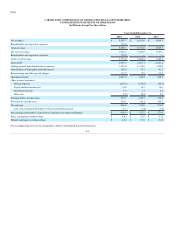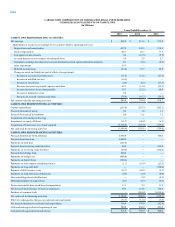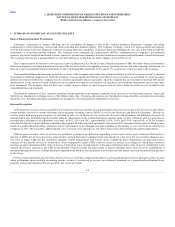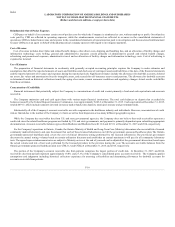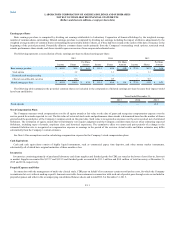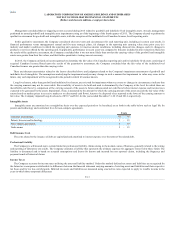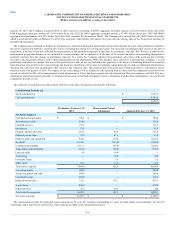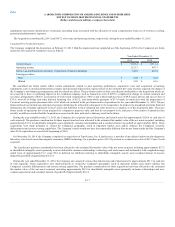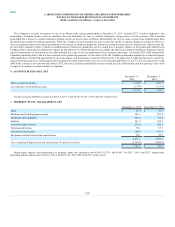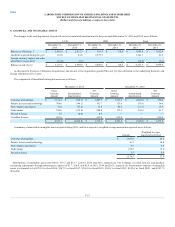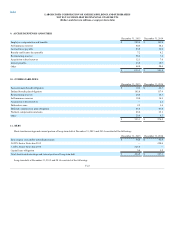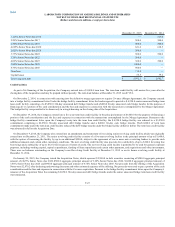LabCorp 2015 Annual Report Download - page 93
Download and view the complete annual report
Please find page 93 of the 2015 LabCorp annual report below. You can navigate through the pages in the report by either clicking on the pages listed below, or by using the keyword search tool below to find specific information within the annual report.
Index
Management concluded that no triggering events occurred during 2015 related to goodwill and indefinite-lived intangible assets. As such, management
performed its annual goodwill and intangible asset impairment testing as of the beginning of the fourth quarter of 2015. The Company elected to perform the
qualitative assessment for goodwill and intangible assets, with the exception of the indefinite-lived Canadian licenses, for all reporting units.
In this qualitative assessment, the Company considered relevant events and circumstances for each reporting unit, including (i) current year results, ii)
financial performance versus management’s annual and five-year strategic plans, iii) changes in the reporting unit carrying value since prior year, (iv)
industry and market conditions in which the reporting unit operates, (v) macroeconomic conditions, including discount rate changes, and (vi) changes in
products or services offered by the reporting unit. If applicable, performance in recent years was compared to forecasts included in prior valuations. Based on
the results of the qualitative assessment, the Company concluded that it was not more likely than not that the carrying values of the goodwill and intangible
assets were greater than their fair values, and that further quantitative testing was not necessary.
In 2015, the Company utilized an income approach to determine the fair value of its Canadian reporting unit and its indefinite-lived assets consisting of
acquired Canadian licenses. Based upon the results of the quantitative assessment, the Company concluded that the fair value of the indefinite-lived
Canadian licenses was greater than the carrying value.
There are inherent uncertainties related to the factors described above and judgment related to the Company's impairment assessments of goodwill and
indefinite-lived intangibles. The assumptions underlying the impairment analyses may change in such a manner that impairment in value may occur in the
future. Any such impairment will be recognized in the period in which it becomes known.
Long-lived assets, other than goodwill and indefinite-lived assets, are reviewed for impairment whenever events or changes in circumstances indicate that
the carrying amounts may not be recoverable. Recoverability of assets to be held and used is determined by the Company at the level for which there are
identifiable cash flows by comparison of the carrying amount of the assets to future undiscounted net cash flows before interest expense and income taxes
expected to be generated by the assets. Impairment, if any, is measured by the amount by which the carrying amount of the assets exceeds the fair value of the
assets (based on market prices in an active market or on discounted cash flows). Assets to be disposed of are reported at the lower of the carrying amount or
fair value. The Company impaired long-lived assets of $39.7 and $0.0, for the years ended December 31, 2015 and 2014, respectively.
Intangible assets are amortized on a straight-line basis over the expected periods to be benefited, as set forth in the table below, such as legal life for
patents and technology and contractual lives for non-compete agreements.
Customer relationships 10 - 36
Patents, licenses and technology 3 - 15
Non-compete agreements 5 - 10
Trade names 5 - 15
The costs related to the issuance of debt are capitalized and amortized to interest expense over the terms of the related debt.
The Company is self-insured (up to certain limits) for professional liability claims arising in the normal course of business, generally related to the testing
and reporting of laboratory test results. The Company estimates a liability that represents the ultimate exposure for aggregate losses below those limits. The
liability is discounted and is based on actuarial assumptions and factors for known and incurred but not reported claims, including the frequency and
payment trends of historical claims.
The Company accounts for income taxes utilizing the asset and liability method. Under this method deferred tax assets and liabilities are recognized for
the future tax consequences attributable to differences between the financial statement carrying amounts of existing assets and liabilities and their respective
tax bases and for tax loss carryforwards. Deferred tax assets and liabilities are measured using enacted tax rates expected to apply to taxable income in the
years in which those temporary differences
F-13


